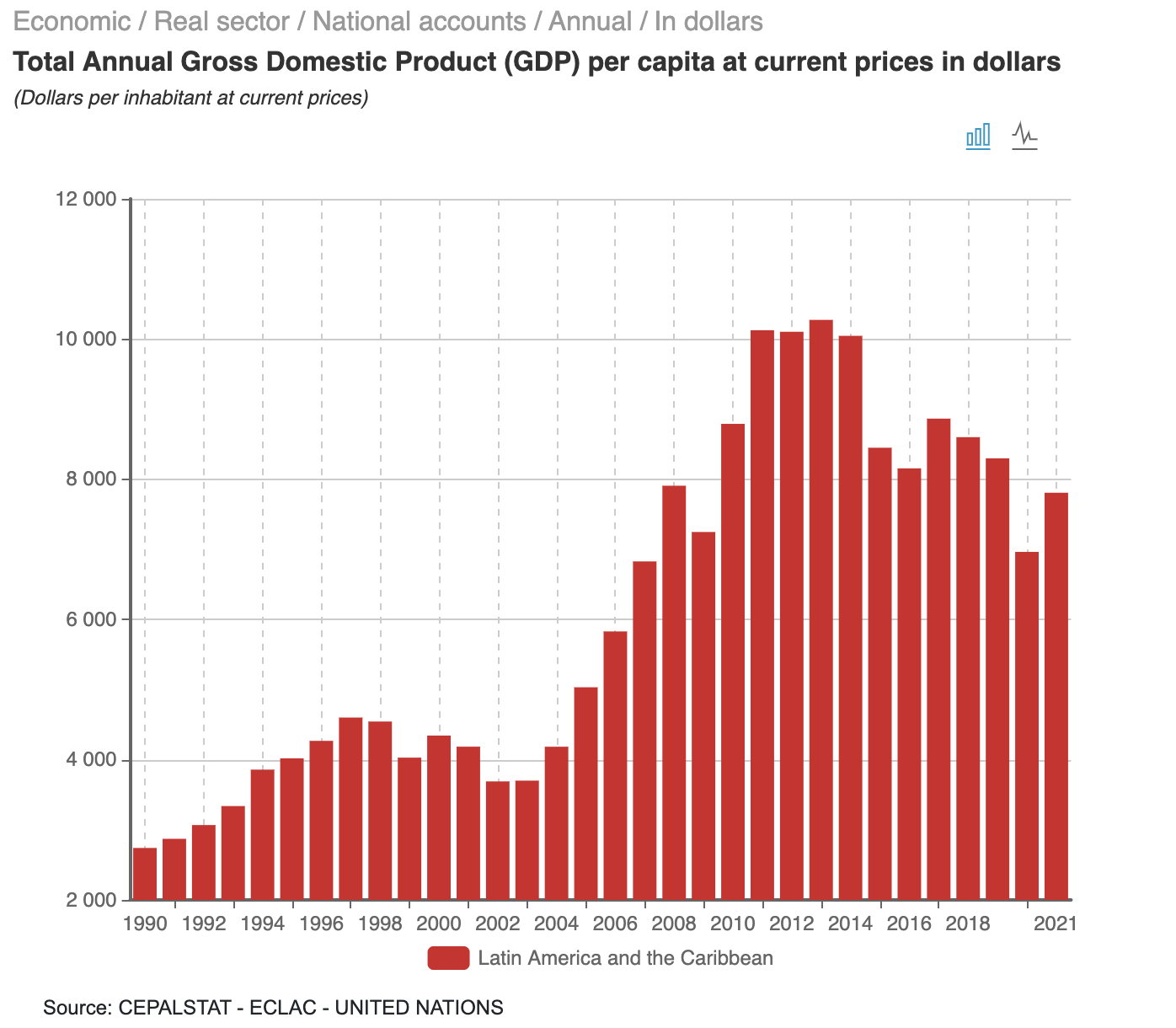(originally published in the World Economic Forum-WEF website on January 19, 2023)
-
It is estimated that the average growth of the countries of Latin America and the Caribbean will be 1.3% in 2023, reflecting a structural trap of low growth, high inequality, weak institutions and poor governance, combined with adverse international conditions.
-
Governments in the region face difficulties in promoting job creation, maintaining spending and social transfers, and investing in education. The region faces the risk of episodes of social unrest.
-
Political priorities must focus on reactivating labor markets, limiting increases in the cost of living, improving tax collection and protecting vulnerable groups, and investing in well-designed social policies and universal healthcare.
2023 is going to be a very difficult year for all the countries of Latin America and the Caribbean: it will mark the end of a decade in which the region’s annual growth rate has averaged just 0.9%, a performance even worse than during the “lost decade” of the 1980s. It’s not just a bad business cycle; it is a structural trap of low growth, high inequality, weak institutions, and poor governance.
A decade of low growth means that the countries of the region have accumulated an even greater set of challenges than before the decade began. Not only the poor and vulnerable have suffered, but also the middle classes, and they are angry. They demand and expect newly elected governments to deliver on their electoral promises, and to do so quickly. People want to see the results reflected in their daily lives. Impatience is great and trust in institutions is low.
Outlook for the economies of Latin America and the Caribbean in 2023
At ECLAC (United Nations Economic Commission for Latin America and the Caribbean) we estimate that the average rate of economic growth in Latin America and the Caribbean in 2023 will be 1.3%. By subregion, this breaks down to just 1% in South America, 3% in Central America and 3.3% in the Caribbean, while Mexico is expected to post a rate of just 1.1%.
These mediocre growth rates will do little to create jobs, nor will they allow governments to create the fiscal space they need to maintain social spending and transfers, invest in education, and create a good environment to absorb growing migration flows. Consequently, the region faces the risk of experiencing episodes of social unrest along with a rising tide of migration.
GDP per capita has decreased in Latin America in the last decade, after having increased considerably in the 2000s Image: ECLAC
Governments are under enormous pressure to deliver tangible results and face difficult compromises in terms of competing demands and objectives. Governance styles and procedures matter: political spaces for social dialogue and for listening to and engaging with different groups will be an essential part of democratic governance in these harsh crisis conditions. Institutional quality and effectiveness also matter: it is impossible to achieve results unless the relevant institutions have a minimum of technical, operational and political capacities, and are transparent and accountable.
In light of this situation, the key policy priorities for Latin America and the Caribbean should be:
-
Promote the greatest economic reactivation possible to create employment and boost the labor markets.
-
Continue efforts to reduce inflation and limit increases in the cost of living.
-
Pursue tax reform to improve tax collection and tax revenue, as well as to protect the most vulnerable groups in the region with specially tailored employment and social policies.
-
Create the bases of universal health services, in addition to well-designed social protection policies.
What happens in the international environment makes a difference for growth and fiscal space. Unfortunately, this year – unlike the period after the financial crisis – the three main engines of global growth and main trading partners of the countries of the region have stagnated. In 2023, the United States is expected to grow only 0.7%, the Eurozone only 0.3% and China 4.4%. Thus, Latin America and the Caribbean cannot expect a tailwind from the global economy.
After picking up in 2021, growth rates slow in Latin America and the Caribbean Image: ECLAC/Twitter
8 sources of opportunities that must be taken advantage of
In this context, are there reasons for optimism about the sources of growth, job creation, expansion of fiscal space and reconstruction? Fortunately, the answer is yes, since there are sources of opportunity that the region should take advantage of.
First, the restructuring of global production processes creates opportunities for the region to take advantage of the reconfiguration of the global supply chain and the corresponding production pooling dynamics.
Secondly, Latin America and the Caribbean have great energy potential, both in traditional energies such as hydrocarbons, and in renewable, clean and modern energy sources, such as solar, wind and green hydrogen. FDI (foreign direct investment) inflows and opportunities in the energy sector remain very important.
Thirdly, there are also opportunities in new modes of production associated with new technologies related to the circular economy, electromobility, digital transformation and the explosion of opportunities in exports of modern services, such as e-commerce, fintech, back-office services and shared services.
“Governance styles and procedures are important: political spaces for social dialogue and for listening and engaging with different groups will be an essential part of democratic governance in these harsh crisis conditions.”— José M. Salazar-Xirinachs, Executive Secretary of ECLAC
Fourth, 2023 promises to be a year of strong recovery for tourism, a vital sector for much of the Caribbean, Central America, Mexico and other countries.
Fifth, just as 2022 was the year of the interest rate crisis, 2023 may be the year of rate stabilization or even the year that rates turn around, a change that may reduce the cost of debt service and can ease restrictions on access to new financial resources.
Sixth, improvements in the international financial architecture to create multilateral debt renegotiation mechanisms will also be very beneficial, not only for the Latin American and Caribbean region, but for all emerging and developing economies.
Seventh, 2023 can also be a good year for regional integration, although this depends on the political commitment and pragmatism of the political authorities in the region. Let us remember that the region itself is the main destination for its manufactured exports. The current geopolitics of globalization make even more evident the importance -and the urgency- of modernizing and deepening the regional integration frameworks.
Eighth, in terms of social rights and social development, Latin America and the Caribbean could have a great year ahead of it, based on the important advances achieved in terms of gender equality, for example, and the emphasis placed on this area by regional leaders during the recent XV Regional Conference on Women in Latin America and the Caribbean, among other commitments signed in different regional forums. The region has an ambitious agenda to promote comprehensive care systems, move towards a care society and increase the participation rate of women in the labor force, currently 24% lower than that of men. In addition, the region has a unique opportunity to promote universal social protection systems and strengthen the education and health sectors.
A pragmatic agenda for growth
It is essential that the countries of the region make the most of these and other opportunities to recover a positive spirit based on pragmatic agendas of growth, employment and better social conditions.
Furthermore, this will be crucial to avoid further fractures and polarization in social contracts or even democratic regression, which is arguably the greatest risk for Latin American and Caribbean countries in these difficult and turbulent times.














